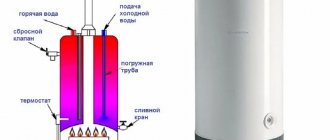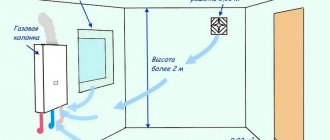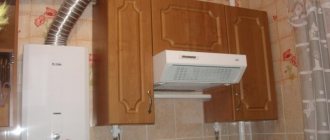We have a gas water heater installed. Everything is installed according to the rules. We would like to install a gas 2-circuit boiler in its place. Tell me where we should start and where to go? And is such a replacement even possible? Thank you in advance.
Answers and comments
According to the amendment to the rules of technological connection No. 1203 dated November 16, 2016, if the replacement of in-house gas equipment does not entail a change in the value of the permitted MCRG, such replacement is carried out by the applicant independently. The subscriber is obliged to notify the gas distribution company. organization to carry out such a replacement within 5 working days from the date of replacement.
But! It is not safe to replace equipment yourself! Therefore, contact Gorgaz with an application for permission. All actions to replace equipment must be carried out by specialists with special permits and knowledge.
If replacing equipment entails an increase in the permitted maximum hourly gas consumption, you need to contact the State Distribution Organization with an application to increase capacity. The GRO is obliged to conclude a TP agreement with you; the cost of such an agreement is equal to the standardized C8 tariff rate approved for the GRO in your region.
add a comment · Was this answer helpful to you? Not really
Is it possible to dismantle the dispenser yourself or call gas workers? At what distance from gas pipes is it permissible to install an electric boiler?
Tags: column, boiler
Comments 50
You don’t have the right to remove the pump without a gas man; there is criminal liability for interfering with the gas supply system (I’m saying this as a former gas man). But you can call your local gas specialist, for example, due to a leak, and discuss this issue with him. We are all human, there are no issues that cannot be solved. But DON’T go there yourself, it will be very expensive later
You can, but: 1. The new equipment will not be covered by the warranty. 2. The newly installed will have to be registered with the gas service. 3. Loyalty to the local gas service. In M.O. for example, they started tightening the nuts. Formally, the gas service can stop supplying gas if there are violations. (automation malfunction, gas leak, lack of a service contract, etc.)
Even if you are going to change it temporarily, it is better to do it through the gas workers, they should have kept the certificates when installing the gas water heater and when you install the new boiler, I think they will have questions. Or do you want to install the boiler yourself?
in general, I kind of wanted to install the boiler myself, then just call them and officially screw them to the gas pipe
I meant the connection. That’s when they may have questions about who and when disconnected the old column.
in general, I kind of wanted to install the boiler myself, then just call them and officially screw them to the gas pipe
You can probably install it yourself.
I installed another one with the same name but more powerful, they came to check and asked who installed it? The mother-in-law said that you probably installed it, and wrote down a new one in the maintenance plan and that’s it. the old one fell apart.
Geyser topic - the point is to turn it off
my wife doesn’t want a water heater, and the boiler has already been bought) for us it’s like half a year
hat it is. get out of here and don't go to anyone else
Gas is cheaper than electricity. Leave it on gas.
Well, gas is becoming more expensive here... Everyone is switching to electric... 
Don't forget to install a safety valve or expansion tank)
Read the link more carefully. The valve and fuses did not work. For fans of nigella, photos of similar cases in Yandex pictures: www.google.ru/search?q=%D...Q_AUICigC&biw=360&bih=559
I have had a 100 liter electric Thermex with an expansion tank and a safety valve for more than 7 years. Why doesn't it explode? How long to wait before the explosion? ) IMHO a gas water heater is more dangerous.
When did you do the last thing? Z.Y.: You’re smiling in vain. I personally experienced this.
I'll be there in a month. I replace the magnesium anode every year.
Is the tank permanently on? If so, then it will work with the annual one for a long time... Is the body of the circuit breaker melted (even a little)? He is the main cause of such troubles. Z.Y.: my father-in-law has a double-circuit electric hot water boiler in the garden... At a speculative price with pick-up, who needs it;)?
Geyser in the kitchen
A column or instantaneous water heater is a device that, due to the combustion of gas, warms up flowing water. Gas can either be supplied through pipes or be liquefied from a cylinder. But in practice, only natural gas is used in city apartments. For many old houses, a water heater is the only way to heat water, because the power of the wiring is not designed for the use of kitchen boilers.
Instantaneous water heaters are often used when planning a small kitchen in Khrushchev and Stalin buildings. Older models are lit with matches, and heating depends on the flow of water. Now they have been replaced by options with electronic control, auto-ignition and electronic temperature control.
In private houses and large country apartments, gas boilers are used instead of water heaters. Their difference is that the boiler has 2 separate circuits - heating and water heating. The column heats only running water.
Advantages
- fast heating of large quantities of water;
- compact dimensions;
- power does not exceed the capabilities of gas lines;
- direct-flow circuit: less heat loss, heats the apartment only when it is running (relevant in summer), hot water is available as soon as the heater is turned on;
- relative cheapness of use, depending on the price of gas.
Strict requirements for installation and further operation due to the potential danger of the device.
Flaws
- explosion and fire hazard;
- requires good traction, otherwise there is a risk of carbon monoxide poisoning;
- you need a chimney and good ventilation, which should be taken into account in the design of a small Khrushchev house.
Double-circuit gas boilers
Such boilers constructively separate the heating circuits of DHW and coolant, while sanitary water from the DHW circuit does not mix with technical water in the heating circuit. In our climate, they have two main operating modes:
- simultaneous maintenance of temperature in the hot water circuit and heating of the room in winter (or, if necessary, in cold summer);
- summer provision of hot water for household needs when heating is turned off (summer mode).
Operating modes can be controlled manually (for budget models) and automatically, depending on the situation outside the home (for advanced boilers). Double-circuit equipment is divided into two types: with a common or two separate heat exchangers.
Differences between boilers with one bithermal heat exchanger and two separate monothermal ones.
Technical requirements for standards
A column or boiler is a highly dangerous device, so installation is strictly regulated. If the requirements are not met, the gas in the apartment is turned off until the installation site meets all the recommendations of the gas industry. All manipulations with gas appliances must be carried out by certified organizations. A package of documents is also important; without it, the gas will not be connected. How to choose a geyser for an apartment can be found in this material.
- the kitchen area must be at least 8 m2;
- walls and masking panels are made of non-combustible materials;
- the ceiling height in the kitchen is more than 2 m;
- ventilation hole with a diameter of at least 120 mm;
- from the side surface to the wall at least 15 cm, from the front panel - at least 60 cm;
- pipe length maximum 2.5 m, diameter - from 13 mm;
- access to all gas pipes is ensured (they cannot be walled up, they are masked only with the help of an opening box or hang freely);
- the shut-off valve is located close to the heater, its handle is yellow;
- the chimney pipe is not a corrugated air duct for exhaust, but steel or galvanized, at least 1 mm thick;
- there should be a door to the kitchen.
Exploitation
The first start-up of gas and water is carried out only by GORGAZ employees. After installation, gas devices are put on balance; they and the air exhaust system are checked once a year. The suitability of the heaters and boilers that can be serviced by gas fitters is checked at the same time. Some models are not serviced by gas workers; these need to be checked annually by inviting specialists from the service center.
Models with a closed combustion chamber do not require a chimney, but the ventilation of the room must be in good condition.
Number of storeys and other requirements for gasification
So, you have patience and you have the financial opportunity to install autonomous heating in your apartment.
Even if the number of floors is observed, the consequences of explosions in multi-apartment buildings have catastrophic consequences. You can imagine what would happen if this happened in a high-rise building with more floors in a populated area that does not have equipment for rapid high-rise fire extinguishing
First of all, you should clarify which floor you live on. Previously, there were restrictions on gasification from 5 to 9 floors in various legislative acts. Now we can safely take SP 402.1325800.2018 for consideration and in it we see in paragraph 5.18 the requirements for apartment-by-apartment heat supply in residential buildings up to 28 meters high.
If you want to argue with this act, you can try, but in any case, you will need to agree on safety standards with the Ministry of Emergency Situations and other departments, the positive outcome of which is doubtful.
The Technical Regulations on the safety of gas equipment state that the supply of “blue fuel” is possible only if fire safety is ensured, which includes the ability to quickly respond technically to ignitions. And although this document was canceled, its requirements are quite reasonable.
Indeed, the technical ability to quickly extinguish fire on floors above 10 is not possible in every city. Not every roof is equipped with a helipad, not to mention the fact that it is unprofitable to provide gasification in high-rise buildings under construction for various reasons.
But this is a completely separate conversation; the main thing we found out is that the number of storeys in your house should not exceed 28 meters.
Premises for gas-using equipment
Now let's talk about the room itself and the requirements for it. This is necessary in order, again, to avoid unnecessary actions, because if your premises do not comply, there is no point in arranging for gasification.
When installing gas-using appliances, you must follow the current regulations. You can’t put them haphazardly, even if it’s very convenient for you
You don’t need to rummage through a pile of papers, just look at the Rules for the design of gas supply systems SP 402.1325800.2018. These are the latest gas supply design rules by date of issue, which, although included in the list of voluntary use, comply with all the requirements of the Technical Regulations for the Safety of Buildings.
In order not to bother yourself, you will still have time to study SP 402.1325800.2018 in detail, immediately look at part 5 “Requirements for premises...” and find the section “Apartment buildings”. In the first paragraph (paragraph 5.16) we see that the installation of gas stoves in kitchen niches is strictly prohibited.
A kitchen niche, as defined by SP 54.13330.2011, is a room or part of it that does not have a dining area and is used for preparing food. The equipment in it includes an electric stove and supply and exhaust ventilation. In a broader sense, the kitchen area somehow communicates with rooms for other purposes.
Let's return to the other requirements, they are the same as in single-apartment buildings, so we look at paragraph 5.1 and see that, again, gas stoves must be installed in kitchens (in 5.16 these are exactly them), with a height of 2.2 m, volume from 8, 12, 15 cubic meters for 2, 3, 4-burner stoves, respectively.
There must be a ventilation hood, a window with a vent for ventilation and a gap at the bottom of the door of 0.02 cubic meters. meters of area. For boilers, the requirements are the same and do not forget that individual heat generators must have an area of 15 cubic meters.
Gas equipment must not be installed in residential premises, above or below them under any circumstances, especially as this is contrary to current regulations.
For reference, a heat generator room is a non-residential premises in which equipment for supplying thermal energy and auxiliary devices are planned or already located. This applies to gas-using devices - stoves, columns, boilers.
Let's continue about boilers. So, a gas boiler in an apartment, instead of the existing central heating, with a power of up to 50 kW, can be placed in the kitchen, hallway, or non-residential room (except for those with high humidity - these are saunas, bathrooms, toilets).
If the power of the device in combination with others is higher, but does not exceed 100 kW, a separate boiler room will be required. Please note that, again, there should be no living quarters in the apartments above or below.
Standards for distances and structures
We talked about the placement of the boiler room, the height from floor to ceiling, now we will discuss the room itself, where a gas boiler can be installed in the apartment, what distances to gas-using equipment must be maintained and what other structures should be in the room.
The passports for the devices already indicate the required distances, requirements for surfaces, and again, our SP 402.1325800.2018 requires that manufacturers’ recommendations be followed
However, there are also mandatory standards. For example:
- Speakers and boilers with wall mounting must be installed on surfaces with fireproof material or fenced with special tempered glass and at a distance from the walls of at least 3 cm.
- Wood floors or floors with a wood finish are not allowed for installation of gas-using equipment unless they are covered with insulation up to a 10 cm projection beyond the located equipment with fire-resistant material.
- The horizontal distance from the stove to the heating equipment is taken to be 10 cm.
However, equipping heating devices in accordance with these requirements will not be so difficult. It’s much more difficult to think through a hood and a window.
Exhaust ducts and window structures
Let's start with the fact that if you plan to place any gas-related equipment, ventilation should be of a natural type.
The hood is equipped with the calculation of threefold air exchange with the same influx and additional air supplied to support combustion. The air supply to the boiler is carried out through a separate channel.
A window opening equipped with glass must be easily removable and meet the requirements of GOST R 56288. Nothing else, no triplexes, reinforcement, etc. can be installed in the boiler room if there are no other windows
As for the window, it should be an easily removable structure. Volume - 0.03 sq. meters per 1 cubic. meter of room volume. And the door leading from the room should open outward.
And, of course, don’t forget about installing the IPU.
Separately, there are also mandatory recommendations on smoke ducts and ventilation, which you will find all in the same SP 402.1325800.2018.
Nuances of gasification of an apartment building
The process of gasification of apartment buildings can be autonomous or centralized.
In the first option, fuel is taken from the common pipeline, and in the second, the supply comes from special tanks that supply and store the gas resource, called gas holders.
The installation of gas tanks is unlikely in densely populated neighborhoods with apartment buildings, since the following conditions must be met during their implementation:
- Possibility of passage of vehicles for servicing tanks.
- The distance from any residential facilities is at least 10 meters, from fences - at least 2 meters, from other buildings - from 5 meters.
- From reservoirs, wells and other wells - 15 meters.
With centralized gasification, all requirements have already been met.
In addition, we note that the laying of the gas pipeline in any case is carried out along the facade above the windows of the 1st floor. In this case, the input passes through kitchens or non-residential premises, and its interfloor transit also passes
Of course, there are many more nuances depending on the specific location of the house, its structural structure, and so on. You can check this information with your local government.
Installation algorithm
Documentation is regulated by the law on gas supply to the population. The list differs depending on whether you are changing only the model, device and location, or if you are installing the equipment for the first time.
The model is changing
- Buy a certified gas heater that is approved for installation.
- Take from the housing office certified copies of the gas and water supply system diagrams with the equipment installation location clearly marked.
- Then take the application for replacement, subject to maintaining the installation location, to the gas service, and also submit applications for the repair of water and gas mains on the site.
- The gas service will do the work, and it will issue a certificate of commissioning of equipment and compliance with the requirements.
Changing the device and installation location
How to install a gas water heater video master class:
- You will need to change the gas supply, water supply, and air venting.
- Come to the fire department to pick up a chimney condition report.
- Order a transfer project from GORGAZ or a private certified organization and receive it.
- An apartment building will require permission for redevelopment from the city administration.
- You must have in your hands an act, a project, a permit, a technical passport of the boiler or water heater, a document on the ownership of the apartment.
With these documents and the application, contact the gas service again.
- Specialists will install and connect the equipment and conduct the first start-up. Then they will seal the meter and issue a Certificate of Commissioning.
- At the end, you should have in your hands documents that confirm safety in the kitchen from the fire inspection, technical supervision, and commissioning. Information about the transfer is additionally submitted to the BTI.
Procedure for registration of gasification of an apartment
First of all, it would be a good idea to find out whether it is even possible to gasify residential buildings in your apartment building or whether there is no such technical possibility. This can be done at the local management company and state registry office.
The management company, if it has a design engineer, can advise you on the possibility of gasifying an apartment in an apartment building. But this point also needs to be clarified with the gas distribution department, based on the load on the nearest line and the ability to connect to it
A preliminary conversation is needed in order not to waste time collecting documentation and going to authorities, if it is still unrealistic to do this.
After receiving approval, you will need to gather the residents and get a positive decision from them with the minutes of the meeting.
Let's look at the Housing Code of the Russian Federation. It contains all the points concerning the nuances of reconstruction of residential premises, starting with Article 25. Gasification is a reconstruction, as it relates to engineering communications, the change of which requires inclusion in the technical passport of the residential premises.
Work is carried out, in accordance with the law, at the expense of the owners of residential premises. That is, from the gas inlet to the in-house gas equipment, if your region does not provide any preferential program, you fully pay for all communications and work. As well as design, construction, installation and commissioning activities, re-equipment of existing heating networks.
Next, you need to go to the local government and write an application for reconstruction, as well as obtain approval for gasification of the apartment with the management company.
After this, you need to submit an application for technical specifications to the local gas distribution organization that services highways in your area. Do not forget to also obtain the consent of the owner of the gas pipeline.
On a contractual basis, an organization that has a license for this type of work should be entrusted with checking the chimney and ventilation systems, as well as their arrangement or reconstruction.
The gas supply project includes a communications diagram from the entrance to the house, the passage of pipes through intra-house structures, and installation locations for gas-using equipment
The project and estimate work are being developed, after which it is necessary to write an application to the local heating network to disconnect from the general heating and hot water supply.
Purchasing equipment for gas use is a very important and responsible moment. You can’t just go out and buy the first stove or boiler you come across that matches the color of your handbag. Devices must comply with the requirements of SP and GOST.
After all this is ready, specialists install gas pipeline pipes and install in-house gas-using equipment according to the approved design.
The next step is the installation of metering devices, as well as alarms, in accordance with SP 402.1325800.2018. When everything is established, a series of contracts for servicing gas-using equipment and for gas supply are concluded between the gas supply organization and the applicant.
Gas is approved for operation and tested, and safety instructions are provided to the owner.
Here, perhaps, are all the stages that need to be completed on the path to gasification of an apartment.
Prohibitions for owners of gasified apartments
Once you have autonomous heating at your disposal, you shouldn’t think that you can now use gas as you please. There are certain restrictions and prohibitions.
During the commissioning of gas appliances, as well as during maintenance, specialists provide instructions on the rules for using the equipment and make comments to the owners if they notice minor violations
For example, it is strictly forbidden to carry out unauthorized gasification. What this includes is the output of gas pipes to local gazebos, garages, sheds, basements, and so on. Connecting equipment not registered with the State Register, even if you just want to exchange one device for another. To do this you need to invite specialists.
You cannot remodel a room into which gas is supplied without prior approval. It happens that after the devices are installed, people begin to remove temporary partitions.
Don't think that such a trick will go unnoticed. At the next maintenance, your ingenious design may be destroyed. SP and SNiPs regulating the installation of gas boilers in an apartment are not canceled after installation of the devices.
It often happens that users turn off automation and alarms if they are triggered by an equipment malfunction. It is not recommended to do this under any circumstances; remember that you are risking not only your property, and most importantly your life, but also other people, since you live in an apartment building.
Another reasonable requirement is that you cannot leave devices that are not designed for long-term burning unattended during your absence. We are, of course, talking about gas stoves and running instantaneous water heaters, even if they are equipped with an automatic emergency shutdown. After all, we are talking about explosive and flammable gas fuel.
Gas should not be used for other purposes (household appliances). Yes, and it is prohibited to sleep in boiler rooms; after all, it’s not for nothing that these rooms should be of a non-residential type.
Violation of the rules for operating gas-using equipment leads to explosions and fires. Having noticed problems in time, specialists can also turn off the gas supply and terminate the contract with the apartment owner
In general, each owner of a gas distribution facility must be instructed regarding their rights and obligations before placing the gas pipeline into operation.
Responsibilities of the owner of a gasified apartment
If you have become the happy owner of an autonomous heating apartment, remember that you have not only prohibitions, but also responsibilities. You are required to follow the rules for using gas at home.
Among them:
- the need to carefully study the instructions for using gas-supplied devices;
- carefully monitor the optimal functionality of all devices, chimneys and ventilation ducts;
- carefully ensure that the draft is at the proper level and periodically clean the smoke exhaust duct;
- immediately report to the gas distribution department about all problems that arise with the equipment under control, in particular about possible leaks outside the apartment on the gas supply;
- in the event of a sudden loss of gas supply, close all valves on the burners and supply pipes, call 04 to clarify the reasons;
- at any time of the day, allow gas distribution department employees to inspect equipment when a signal is sent to their office about a possible emergency;
- admit specialists for maintenance and inspections;
- timely pay for the resources received according to the indications of the IPU;
- Keep children away from operating gas appliances.
Among other things, when leaving for more than a month, you must notify the gas service and leave them your current telephone number for contact in the event of a malfunction on the line.
Even a slight leak in the line over the long term can cause an explosion or fire. Therefore, when leaving, do not leave even locked durable equipment unattended for long periods of time.
The requirements are not so complicated; it won’t be difficult to comply with them, and it will also ensure your safety.
List of documents according to standards
The list below is approximate and as complete as possible, but it depends on the region. In addition, if the connection is not happening for the first time, some documents may already be in the relevant services or in the hands of the owner of the apartment building/in the housing office. How to make an air duct for a kitchen hood can be read in this article.
So, you will need:
- A copy of the home or apartment's title deed or similar document proving that you are the owner.
- Copies of civil passport (pages 2,3 and 5).
- Copies of the tax payer's certificate (TIN).
- Permission to process personal data.
- Gas Buyer's Passport.
- Your letter about concluding a work contract.
- Maintenance contract for fire hazardous equipment.
- Specifications for gas connection issued by the distributor or supplier.
- Documents on the implementation of specifications (Acceptance certificate for the gas distribution system facility (copy) and others).
- List of equipment using gas, its characteristics, copies of technical passports.
- A copy of the deed on the division of property between the owner of the house and the distributor.
- Copies of passports for the gas meter, additional sensors if available, and certificates of verification.
- A copy of the gasification project page with the stamp of the Gazprom metrology department.
How to install a gas water heater in an apartment:
Regulations, laws and regulations
Let's immediately look at what decrees regulate such connections at the legislative level. They will help you implement your plans without problems with local authorities, without danger to health and life, and, moreover, with minimal waste of time and money.
You will need for review:
- SP 60.13330.2016 - “Heating, ventilation and air conditioning.”
- SP 62.13330.2011/SNiP 42-01-2002 - this describes gas distribution systems in detail.
- SP 41-108-2004 - a document on apartment-to-apartment heat supply using gasification.
- SP 402.1325800.2018 - “Rules for the design of gas consumption systems.”
And of course, general research into the documentation of your apartment building is necessary.
Types of heaters and boilers for apartments (including Khrushchev)
If we talk about gas heaters, they can be flow-through or storage. But in Russia, gas boilers are not widely used, because they are less convenient, cost more and take up a lot of space. They should only be installed if the gas supply is too weak. Mostly they install instantaneous gas heaters. You can find out how many sockets you need in the kitchen here.
Modern models may have a closed or open combustion chamber. Open ones are a little safer and require less paperwork during installation. They are needed if there is no chimney in the house. The latter are suitable if the old heater is being replaced with a new one, the chimney and gas supply have already been made and tested.
Suppliers offer 3 types of power. 17-20 kW is needed for a one-room apartment with 1 inhabitant. If a person takes a shower, there is no longer enough power to wash dishes. Devices with a power of 20-26 kW are indispensable for apartments. They provide 15 liters of water per minute at a temperature of 40 degrees. The power of an average heater is enough for a family of 4 people and an apartment with 1 shower and 2 sinks. A power of 26-28 kW is suitable for two-level apartments or houses. You can find out what kitchen hoods there are by following this link.
When heaters are not allowed to be installed in an apartment or house
- If you live in a one-room apartment where the living room and kitchen are combined. The kitchen should be a separate room.
- If you want to install a gas heater in a living room, bathroom or on a loggia/balcony.
- If there is a blank door under the kitchen door, there is no ventilation slot.
- If the length of the water and especially gas hoses is more than 2.5 m.
- If a gas stove or other source of open fire is almost adjacent to the boiler.
- If you plan to hang the heater on a wall adjacent to the living room.
How to create autonomous heating in the kitchen, video:
Boilers and water heaters allow you not to depend on the whims and standards of warm water suppliers and provide a comfortable, normal water temperature at any time of the year. Although the requirements for their installation may seem too strict, this is done for the safety of residents. It is better to immediately install the equipment correctly and according to the standards than to pay later for its removal and reconnection of gas. What filters are needed for water purification in a private home can be found here.











